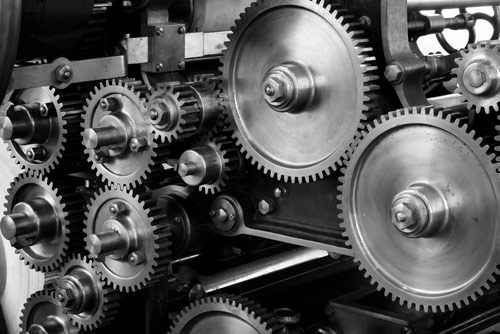
Preventative maintenance is necessary for any sort of industrial automation. Engineering better maintenance strategies for robots will increase their lifespans markedly. This will help ensure manufacturing automation equipment continues to perform properly and with sufficient accuracy on a day-to-day basis, along with guaranteeing the manufacturer’s best return on investment (ROI).
In the world of manufacturing, automation equipment failures are mitigated by conducting preventative maintenance, leading to lower repair costs, less downtime, more uptime, and more predictable timetables for fabrication. Implementing maintenance routines to prevent breakdowns helps maximize productivity in any industrial environment that utilizes robots and other custom automation.
Maintenance Strategies for Manufacturing Automation Equipment
Developing a proactive maintenance strategy involves careful planning. Maintenance needs to be scheduled and implemented at times when it least affects production. Preventative maintenance should focus on achieving specific goals, which should be at least initially coordinated with a knowledgeable custom automation integrator.
Preventative maintenance strategies for manufacturing automation may include:
- Establishing a schedule for all maintenance tasks.
- Inventory of all robotic components, contained in an easy-to-use database.
- Monitoring performance on a continuous basis of any robot or other automated equipment.
- Placing responsibility as to who will conduct which task.
Developing a preventative maintenance strategy for robots and other manufacturing automation also involves identifying specific tasks and when they should be scheduled. As an example, examining lubrication levels of any automated equipment will help extend a robot’s lifecycle by controlling friction, heat and vibrations, which all cause wear to automation. Engineering analyses like these also help operators know when it’s time to conduct certain maintenance operations.
Preventative Checklist for Industrial Robots
Though each robot along an assembly line will follow an individualized maintenance schedule that’s customized, automation checklists should occur at routine intervals in order to prevent unforeseen breakdowns.
Some basic items to add to this checklist include:
- Assessing control cables, connections, power supplies and safety equipment for wear and tear
- Backing up memory controller
- Checking overtravel limits to prevent unnecessary movements
- Cleaning cooling fans and vents
- Evaluating batteries that control automated motion
- Examining teach pendants to ensure remote operation
- Inspecting brakes
- Listening for any excessive vibrations or other audible noises that may indicate mechanical issues
- Lubricating balancer housings, bushings and joints
- Making sure a robot will continue to repeat required actions
- Monitoring how a robot moves by inspecting cables, harnessing and main bodies of manufacturing automation equipment
- Removing any debris from the robot’s exterior or interior
- Removing dirt or other obstructions from sensors
- Testing for any lubricant leaks or faulty seals
- Tightening any loose external bolts
Any elements or components of a robot or other manufacturing automation equipment that doesn’t meet required standards should be adjusted, replaced or repaired as soon as possible. A knowledgeable robot integrator can help with setting up an appropriate checklist.
Establish a Maintenance Schedule
Effective maintenance strategies incorporate strict schedules that should be followed for all automation. Engineering maintenance timelines according to manufacturer specifications and following these timelines meticulously will help keep equipment in working order and production lines running. Often manuals for custom automation equipment provide recommendations on daily, monthly and annual maintenance tasks, though increasing the frequency of these checks will help prevent equipment failures.
Benefits of Maintenance
Utilizing preventative maintenance procedures has many advantages for any type of manufacturing automation. Engineering a proper maintenance plan with regular inspections reduces unscheduled downtime and extends a robot’s lifecycle, contributing to higher productivity.
Regular preventative maintenance helps to:
- Decrease energy use: When worn, robot components often use more energy to run. Though this usage may initially be barely perceptible, poorly maintained automated equipment can increase energy expenses. Industrial robots need regular maintenance to ensure they function efficiently.
- Enhance product quality: Often wear and tear of an industrial robot will decrease the quality of products it produces. Even with tiny changes in automation, engineering errors can be introduced into end products. Not only does this lead to less than perfect products, it also affects consumer perception of those products. Prevention of failures and faults helps ensure quality.
- Extend equipment lifespans: Robot lives are extended considerably with regular preventative maintenance. With it, custom automation can last years longer, offering a better ROI.
- Minimize downtime: Though planned inspections and maintenance may stop production briefly, unplanned stoppages usually cost much more. Problems with malfunctioning robots need to be identified and repaired, time which takes away from production. Smaller problems are much simpler and more economical to fix during routine maintenance than when conducting major repairs after an equipment failure, where a failing component often causes more damage.
- Reduce fabrication times: Basic maintenance helps ensure robots operate as effectively and efficiently as possible. Lack of lubrication or worn-down parts will inevitably slow down manufacturing automation equipment, leading to longer production times. For this reason, regular maintenance is necessary.
Factoring in all these advantages of preventative maintenance diminishes costs generally and raises productivity for manufacturers who utilize automation. It also encourages robot operators to follow maintenance protocols, while also helping sustain an orderly production facility.
Using Automation Engineering Experts for Maintenance & Repairs
When it comes to automation, engineering firms that specialize in maintaining or repairing robots should be a consideration. Often these experts help assess a manufacturer’s needs, helping to customize regular maintenance schedules that best meet the needs of the company.
